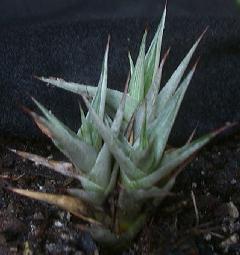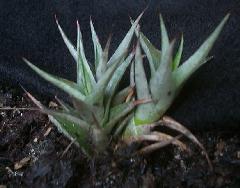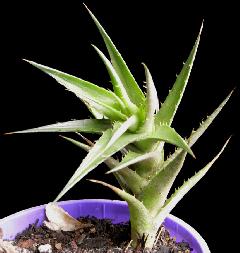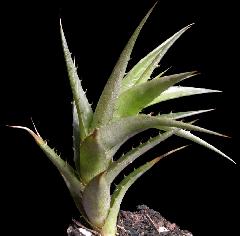



Ed. The herbarium specimen that gave rise to "Abromeitiella lorentziana" was found to actually be a brevifolia.
brevifolia is the older name and so takes precedence. (Note also that all Abromeitiella genus have been moved to Deuterocohnia)
But where do the many different forms of lorentziana in our collections go ?
Derek Butcher advises that most in Australia have been re-labelled brevifolia 'Large form', but some seem closer to abstrusa, so compare your plants against the following descriptions.
I have always had problems trying to work out if I was growing D. brevifolia or D. lorentziana and kept returning to the key in Smith & Downs (1974).
Key to the Species of Abromeitiella
1.Leaves not over 22 mm long; sepals not over 13 mm long. Southern Bolivia, northwestern Argentina. => A. brevifolia
1. Leaves 50-150 mm long; sepals 16 mm long, Northwestern Argentina. => A. lorentziana
My problem was that I had some plants that did not agree with these measurements and were in between. What species name should I use?
Some were distinct and were given Cultivar names such as ‘Chlorantha’ and ‘Little Marj’ so I was pleased when I received a copy of a dissertation done by Nicole Schuetz in 2011 on the genus Deuterocohnia. She did publish details on Deuterocohnia meziana Kuntze ex Mez (1896: 465) by Nicole Schuetz in Phytotaxa 162(1): 18-30. 2014 but refrained from publishing the following:
Plants growing in dense cushions.
Rosettes 7-14{-20} x 5-12 {-15} cm.
Leaf sheaths 0.5-1.3 x 1.5-2 cm.
Blades 4-8 x 1-1.8 cm, recurved to straight, adaxially concave to plane, spinose- serrate, lepidote, greenish-greyish.
Peduncle absent.
Inflorescence simple, annual, 1-3-flowered.
Floral bracts 9-13 x 3-4 mm, much shorter than the sepals, ovate, acute, mucronate, sparsely lepidote, greenish to brownish.
Flowers 26-32 {-35}mm long, sessile.
Sepals 10-14 x 3-4 mm, ovate to lanceolate, obtuse, mucronulate, sparsely lepidote, greenish.
Petals 25-32 {-35} x 4-5 mm, erect during anthesis, after anthesis slighdy spirally twisted, yellow-greenish, with green apex.
Petal appendages 4-5 mm long, with short fringes.
Filaments 20-25 mm long. Anthers 4-5 mm long, erect, concealed, greenish.
Ovary 5-6 mm long. Style 20-30 mm long, stigma exposed.
Fruits 10-12 {-15} mm diam. Seeds 3-4 mm long.
Distribution. BOLIVIA. Dept. Tarija. ARGENTINA. Prov. Jujuy, Salta, Tucuman, Catamarca, La Rioja. 21° 40'-29° 20' S, 64°30'-68°05'W.
Habitat and ecology. Ecoregions: Central Andean puna (156), Andean Yungas (64), Argentina Monte (136). At elevations of 1,500-3200 m a.s.l.
Terrestrial, forming cushions on open, rocky slopes, abundant at its localities. Dry scrub vegetation, in association.with barrel cacti. Flowering time from September to February. Pollinated by insects or birds.
Etymology. The etymology was not explained by Castellanos. It may refer to the concealed inflorescence or the ramification hidden within the cushions. (Latin abstrusus. hidden, concealed).
Affinities. D. abstrusa is morphologically closely related to D. brevifolia, but is characterized by larger rosettes with a laxer leaf arrangement and usually a denser indument. For further information about the delimitation of D. brevifolia and D. abstrusa see 4.2.3.
Notes and comments. (a) Abromeitiella abstrusa has been formerly included in the synonymy of A. lorentziana. The A. abstrusa element is now re-established as an own species and transfered to D. abstrusa, whereas the A. lorentziana element is considered synonymous with D. brevifolia. (b) IUCN: rare (D. lorentziana see 3.5.4).”
Derek Butcher...
I can find nothing wrong with this move and repeat it here for your information.
What action have I taken with plants in my collection? I think I have one clump that qualifies as D. abstrusa with others now treated as D. brevifolia (Large).
Plants growing in dense cushions.
Rosettes 7-14{-20} x 5-12 {-15} cm.
Leaf sheaths 0.5-1.3 x 1.5-2 cm.
Blades 4-8 x 1-1.8 cm, recurved to straight, adaxially concave to plane, spinose- serrate, lepidote, greenish-greyish.
Peduncle absent.
Inflorescence simple, annual, 1-3-floweed.
Floral bracts 9-13 x 3-4 mm, much shorter than the sepals, ovate, acute, mucronate, sparsely lepidote, greenish to brownish.
Flowets 26-32 {-35}mm long, sessile.
Sepals 10-14 x 3-4 mm, ovate to lanceolate, obtuse, mucronulate, sparsely lepidote, greenish.
Petals 25-32 {-35} x 4-5 mm, erect during anthesis, after anthesis slightly spirally twisted, yellow-greenish, with green apex.
Petal appendages 4-5 mm long, with short fringes.
Filaments 20-25 mm long. Anthers 4-5 mm long, erect, concealed, greenish.
Ovary 5-6 mm long. Style 20-30 mm long, stigma exposed.
Fruits 10-12 {-15} mm diam. Seeds 3-4 mm long.
Distribution. BOLIVIA. Dept. Tarija. ARGENTINA. Prov. Jujuy, Salta, Tucuman, Catamarca, La Rioja. 21° 40'-29° 20' S, 64°30'-68°05'W.
Habitat and ecology. Ecoregions: Central Andean puna (156), Andean Yungas (64), Argentina Monte (136). At elevations of 1,500-3200 m a.s.l.
Terrestrial, forming cushions on open, rocky slopes, abundant at its localities. Dry scrub vegetation, in association with barrel cacti. Flowering time from September to February. Pollinated by insects or birds.
Etymology. The etymology was not explained by Castellanos. It may refer to the concealed inflorescence or the ramification hidden within the cushions. (Latin abstrusus. hidden, concealed).
Affinities. D. abstrusa is morphologically closely related to D. brevifolia, but is characterized by larger rosettes with a laxer leaf arrangement and usually a denser indument. For further information about the delimitation of D. brevifolia and D. abstrusa see 4.2.3.
Notes and comments. (a) Abromeitiella abstrusa has been formerly included in the synonymy of A. lorentziana. The A. abstrusa element is now re-established as an own species and transfered to D. abstrusa, whereas the A. lorentziana element is considered synonymous with D. brevifolia. (b) IUCN: rare (D. lorentziana see 3.5.4). For references and Specimens see separate jpg
Deuterocohnia lorentziana (Mez) M A Spencer & L B Smith, Bradea 6(16): 140-5. 1992
Abromeitiella lorentziana (Mez) Castellanos, Lilloa 10: 459. 1944.
Pitcairnia lorentziana Mez, DC. Monogr. Phan. 9: 373. 1896.
Hepetis lorentziana (Mez) Mez, DC. Monogr. Phan. 9: 974. 1896.
Abromeitiella abstrusa Castellanos, An. Mus. Nac. Hist. Buenos Aires 36: 369, pls. 1, 5. 1931. Type. Cuesta de la Chilca, crest of Pucara, Catamarca, Argentina, Castellanos 29/60 (BA, photo, US), 12 Jul 1929.
Desc from S&D
Leaves 5-15 cm long, 8 mm wide, 4.5 mm thick.
Sepals 16 mm long;
petals 32 mm long;
ovary 7 mm long.
TYPE. Lorentz s n (holotype, B; photo 11386, F), Cuesta de la Chilca, Catamarca, Argentina.
DISTRIBUTION. Saxicolous, 1750-1850 m alt, northwestern Argentina.
ARGENTINA. JUJUY: Volcan, 30 Nov 1918, Castillon 6458 in part (BA); Chucalesna to Senador Perez, 21 Jan 1921, Castellanos 1048 (BA); Tilcara: Garganta del Diablo, 29 Jul 1946, Escalante & Agosti 87 (LP); Sierras dc Tilcara, 10 Mar 1957, Cristobal & Turpe 111 (LIL). SALTA: El Alisal, Puerta Tastil to Rio de Lerana, Piccardo 30-A (UC, US). CATAMARCA, Andalgala: Las Minas, 10 Apr 1917, Jorgensen 1773 (GH, LIL, SI, US); Cuesta de la Chilca, 27 Jan 1968, A. T. Hunziker & Di Fulvio 19653 (LIL, US); Tinogasta: Quebrada de San Buenaventura, 7 Feb 1930, Castellanos 30/404 (BA, GH, SI). LA RIOJA: Reported from Cachiyuyal and from Famatina by Castellanos but not verified.
Protologue
Pitcairnia lorentziana Mez, DC. Monogr. Phan. 9: 373. 1896.
15. P. Lorentziana ; foliis ignotis ; inflorescentia scapo nullo nidulante, perdense spicata, adpresse lepidota; bracteis triangularibus, margine spinulosis, perrigidis apice pungentibus; floribus quam bracteae brevioribus sessilibus ; sepalis ellipticis, apice obtusis cucullatisque, symmetricis; petalis ligula latissima instructis, stamina subaequantibus ; ovario fere omnino supero ; ovulis breviter caudatis.
Perimperfecte solum ex inflorescentiis binis perdensis, strobiliformi-subcorymbosis, ad 60 mm. longis, 40 mm. diam. metientibus cognita. Bracteae imbricatae, erectae, basi late albide pellucido-marginatae, satis carinatae, margine infimae spinulis perpaucis corneis, minutis, flavescentibus auctae, perlonge acutae in setam aciculosam flavescentem, validissimam desinentes, utrinque dense lepidibus adpressis albis obtectae ob lucem visae micantes, anguste paleaceo-marginatae. Flores ad 28 mm. longi; sepalis subglabris, tenuibus margine late hyalinis, 11 mm. longis valde naviculari-concavis. Petala 24 mm. longa, lingulata, super basin ligula profunde fimbriatim incisa aucta. Antherae 6,5 mm, longae. Ovarium elongatum subprismaticam, apice subito in stylum gracilem contractum. Fructus ignotus.
Argentina, prov. de Catamarca ad Cuesta de la Chilea : Lorentz. - Floret Februario. (V, s. in herb. cl. Hieron., nunc Berol.)